Panasonic Toughbook 54 Review: Rugged but Rough Around the Edges
Author:OMO Release Date: 2016年3月31日
You can walk into almost any modern electronics store or phone company store and find a smartphone or “phablet” that is waterproof and will survive repeated drops onto concrete. Unfortunately, most stores don’t keep rugged notebooks like the Panasonic Toughbook 54 (CF-54) in stock. As a matter of fact, rugged notebooks are almost exclusively purchased by enterprise businesses deploying workers in hazardous environments or by local and federal government agencies (police, firefighters, soldiers, military mechanics, etc.) with servicemen who require PCs that will survive just about anything.
We took the Panasonic Toughbook 54 and put it through its paces in our lab to see if this sturdy-looking laptop is durable enough to handle some real-world chaos. Keep reading to find out how well it held up.
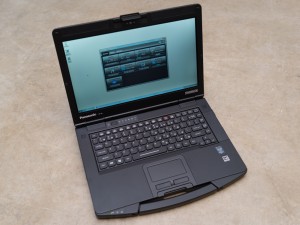
Panasonic Toughbook CF-54
Build and Design
As with most rugged notebooks, the Panasonic Toughbook 54 meets the typical standards for MIL-STD-810G certification (surviving drops from a height of 3 feet, shock, vibration, sand, dust, altitude, high/low temperatures, high temperature tactical, temperature shock, and high humidity).
Panasonic bills the Toughbook 54 as “the world’s lightest and thinnest semi-rugged laptop in its class” and this is indeed noticeably thinner and roughly a full 1-2 pounds lighter than any other rugged notebook that we’ve reviewed. If you’re wondering whether or not Panasonic had to make sacrifices to make this laptop so thin and light the answer is hidden in Panasonic’s description of the Toughbook 54 as a “semi-rugged” laptop.
The screen lid and chassis are made from magnesium alloy, the hard drive is shock-mounted with flex connectors and there’s even a spill-resistant keyboard … but you won’t find all the added structural reinforcement and protection that we typically see in fully rugged notebooks like the Getac X500 or even the much older Dell Latitude E6400 XFR.
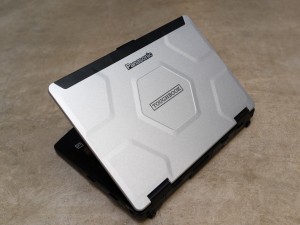
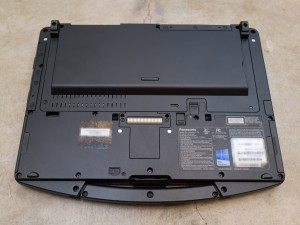
The bottom half of the chassis feels durable at first glance but tap the base plate with your fingernail and you’ll hear an uncomfortably hollow sound suggesting there isn’t much reinforcement inside the center of the chassis. While we’re discussing the underside of this notebook, we should mention the primary storage drive is removable thanks to a quick-release and you can place a second, hot-swappable battery inside the Toughbook 54’s media bay.
Ports and Features
Enterprise clients and government agencies are the principal holdouts of “legacy” technology around the globe. Most consumers or small businesses buying PCs today are content with a couple of USB ports and wireless connectivity, but rugged notebooks frequently need to interface with hardware that was originally built decades ago. That’s why you’ll find seemingly ancient serial ports and sometimes even PS/2 connectors on rugged laptops … and the Panasonic Toughbook 54 is no exception.
The right side of the CF-54 contains a wireless on/off switch, headphone/mic jack, SD/SDXC card reader, two USB 3.0 ports, Ethernet and the power jack. The left side is where you’ll find the optional DVD drive, optional PC Card slot and Kensington lock slot. The rear edge of the notebook conceals the third USB 3.0 port, HDMI, SIM card slot, optional VGA (not included in our review unit), and optional serial port. The front of the chassis contains both the battery status indicator lights as well as a retractable magnesium alloy carrying handle supported by magnesium alloy sliding hinges.
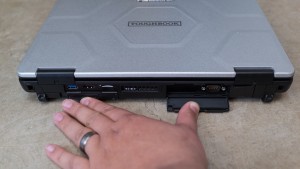
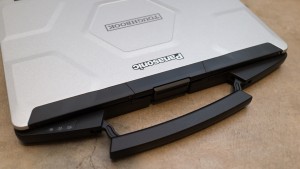
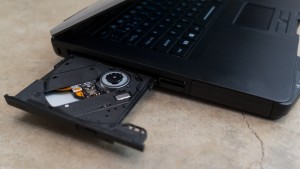
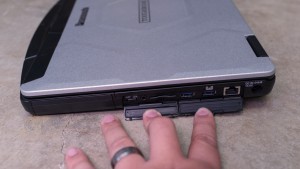
The only two items that aren’t fully protected by a hard cover with a rubber gasket for added waterproofing are the optical drive and the power jack. Honestly, we’re not sure why Panasonic decided to leave these two areas without added protection from water or contaminants like dirt. A pair of rubber flaps or another set of plastic doors with rubber seals would insure that the optical drive and the power adapter continue to operate flawlessly in most environments.
Our review sample of the Toughbook 54 included the optional Panasonic CF-VEB541 port replicator. This desktop docking station provides an additional four USB 3.0 ports, a full-size HDMI port, VGA port, serial port and Ethernet in addition to a second power jack to charge the Toughbook 54 while the laptop is docked.
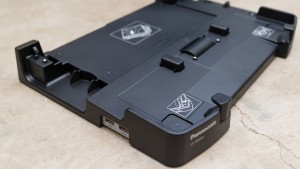
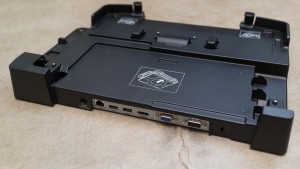
Screen and Speakers
The 14-inch FHD (1080p) IPS touchscreen display with optional 1000 nit backlight in our review unit proved to be quite stunning compared to the typical low-resolution displays found on most rugged notebooks. The touchscreen model we tested is the “gloved multi touch model” that allows users to control touchscreen functions even while wearing gloves in a freezing environment. The 1000 nit backlight also allows you to continue using the screen outdoors even under direct sunlight.

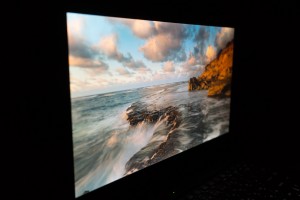
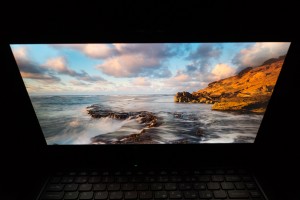
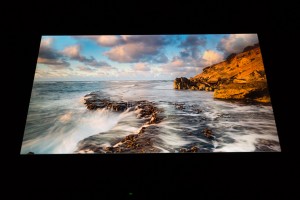
The direct-bonded IPS display panel also features anti-reflective and anti-glare screen treatments to help improve visibility indoors and outdoors. We found the wide viewing angles to be more than sufficient for casual use and extended viewing of streaming video content from Netflix. Our only minor criticism about this display is that the extremely bright backlight isn’t perfectly even across the screen’s surface and we noticed a few “dark patches” when we viewed the screen at odd angles under bright lights.
The built-in stereo speakers located on the upper left and upper right corners of the keyboard are low-wattage speakers that produce volume levels similar to most business notebooks. Although we’re happy about the location of these speakers since they direct sound up and toward the user, the audio sounds flat with virtually no bass and a faint “tinny” echo to the highs. The speakers get the job done if you want to have a webcast conference or hear system alerts … but plan to buy a set of headphones if you care about audio quality.
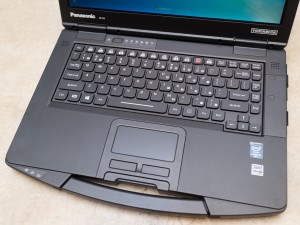 Keyboard and Touchpad
Keyboard and Touchpad
Most experienced users of rugged notebooks know that some rugged notebooks feature a rubber membrane keyboard that is both a blessing and a curse. Rubber membrane keyboards feel “squishy” and the limited tactile feedback frequently causes typos. Nevertheless, those keyboards are waterproof and will continue to work even if the user exposes the keyboard to excessive amounts of environmental contaminants like mud, sand or even oil. That’s not exactly the case with the spill-resistant keyboard for the Panasonic Toughbook 54.
This keyboard features standard Chiclet-style keys with a rubber membrane backing that surrounds each key and protects the underside of the keyboard deck. What this means in practical terms is that the Toughbook 54’s keyboard feels much nicer than the keyboards found on a typical rugged notebook; you’ll notice positive feedback as you press and release each key, and that makes for a more confident typing experience with fewer typos. On the other hand, environmental contaminants (particularly fine granules of sand or soil) will potentially work their way between the edges of the Chiclet keys and the rubber membrane underneath. If enough of those small contaminants get into the keyboard then they may interfere with the action of some keys.
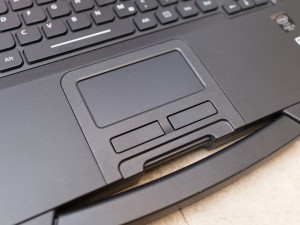 Overall, we believe the superior typing experience outweighs the potential downside … but if you’re working on an oil rig where you need to frequently wipe down your keyboard or if you’re deployed in a place where sand contamination is major concern then this might not be the ideal keyboard for you. We should also mention that the keyboard is available with LED backlighting in all configurations except the “Lite” model.
Overall, we believe the superior typing experience outweighs the potential downside … but if you’re working on an oil rig where you need to frequently wipe down your keyboard or if you’re deployed in a place where sand contamination is major concern then this might not be the ideal keyboard for you. We should also mention that the keyboard is available with LED backlighting in all configurations except the “Lite” model.
The touchpad on the Toughbook 54 is a standard electrostatic touchpad surface with support for multi-touch gestures. The dedicated left and right touchpad buttons work well and are much easier to use in extreme environments than the integrated buttons under “clickpad” style buttonless touchpads.
Performance
We feel the need to address one potential performance-related issue before we take a closer look at the technical specs for our review unit of the Panasonic Toughbook 54. The performance issue that surprised us the most was an unusually lengthy delay during the first startup. After we powered on the Toughbook in our lab we were greeted with the following message:
“Wait several minutes while the optimal configuration is being set. After completing the settings, restart automatically.”
This message appeared on the screen with a white background for at least 4 or 5 cycles of “settings” and “restarts.” The Toughbook was completely unusable for the first 28 minutes after we turned on the notebook for the first time. This isn’t the end of the world, but we haven’t seen any other notebooks priced at more than $1000 that are disabled for nearly a half hour during the initial startup.
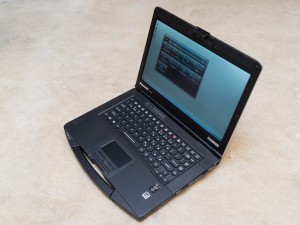 That might not be a problem for the majority of enterprise and government clients that purchase the Toughbook 54 since most of them have IT departments that will re-image the boot drive with a custom installation of the OS and applications before the first startup. That said, if you or your organization plan to purchase this notebook with the factory-installed Windows and install apps yourself then be prepared to turn on the PC and then take a 30-minute coffee break.
That might not be a problem for the majority of enterprise and government clients that purchase the Toughbook 54 since most of them have IT departments that will re-image the boot drive with a custom installation of the OS and applications before the first startup. That said, if you or your organization plan to purchase this notebook with the factory-installed Windows and install apps yourself then be prepared to turn on the PC and then take a 30-minute coffee break.
The beating heart of the Toughbook 54 is the 2.3 GHz Intel Core i5-5300U processor. This fifth-generation, dual-core low-voltage processor with hyperthreading has a maximum Turbo frequency of 2.9 GHz and should be more than enough to handle most CPU-intensive tasks in the field.
The integrated HD Graphics 5500 outperforms the older HD Graphics 4400 and HD Graphics 5000 … just don’t expect to use the integrated graphics for playing most games released in the last two years on anything other than low settings. Broadwell was the first Intel chip to fully support DirectX 11.2, OpenCL 1.3/2.0 and OpenGL 4.3 but if you need the Toughbook to handle CAD or other graphics-heavy applications then you’ll need to upgrade to the optional AMD FirePro M5100 dedicated graphics. Video output from the integrated graphics in our review unit natively supports HDMI 1.4a but the newer HDMI 2.0 standard is not supported.
Panasonic includes a traditional 500 GB HDD as standard (5400 rpm on the “Lite” models and 7200 rpm on all other models) but you may also upgrade to an optional solid state drive (SSD) with either 128 GB or 256 GB capacities. Our review sample came equipped with a 512 GB Toshiba enterprise-class SSD which delivered excellent performance. Honestly, we’re not sure why Panasonic doesn’t offer a low-capacity SSD as the standard storage drive since SSDs are not only faster but are more resistant to shock and vibration than HDDs.
About OMO Electronic Limited
Your Trusted Partner for Distributing OMO Electronic Limited!
Our Mission is to provide the best quality IC components with the best affordable price every time.
We are looking forward to cooperating with you!
